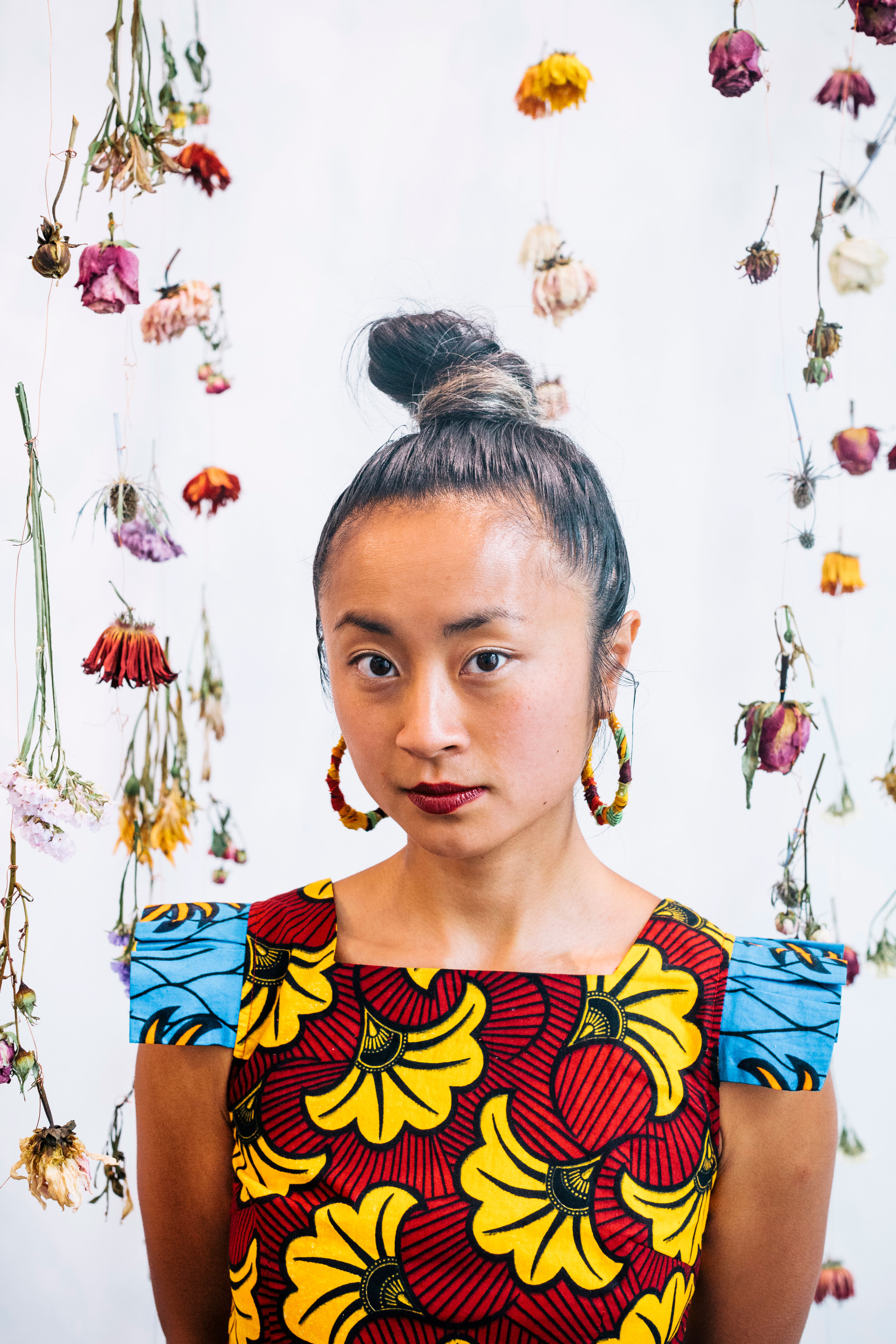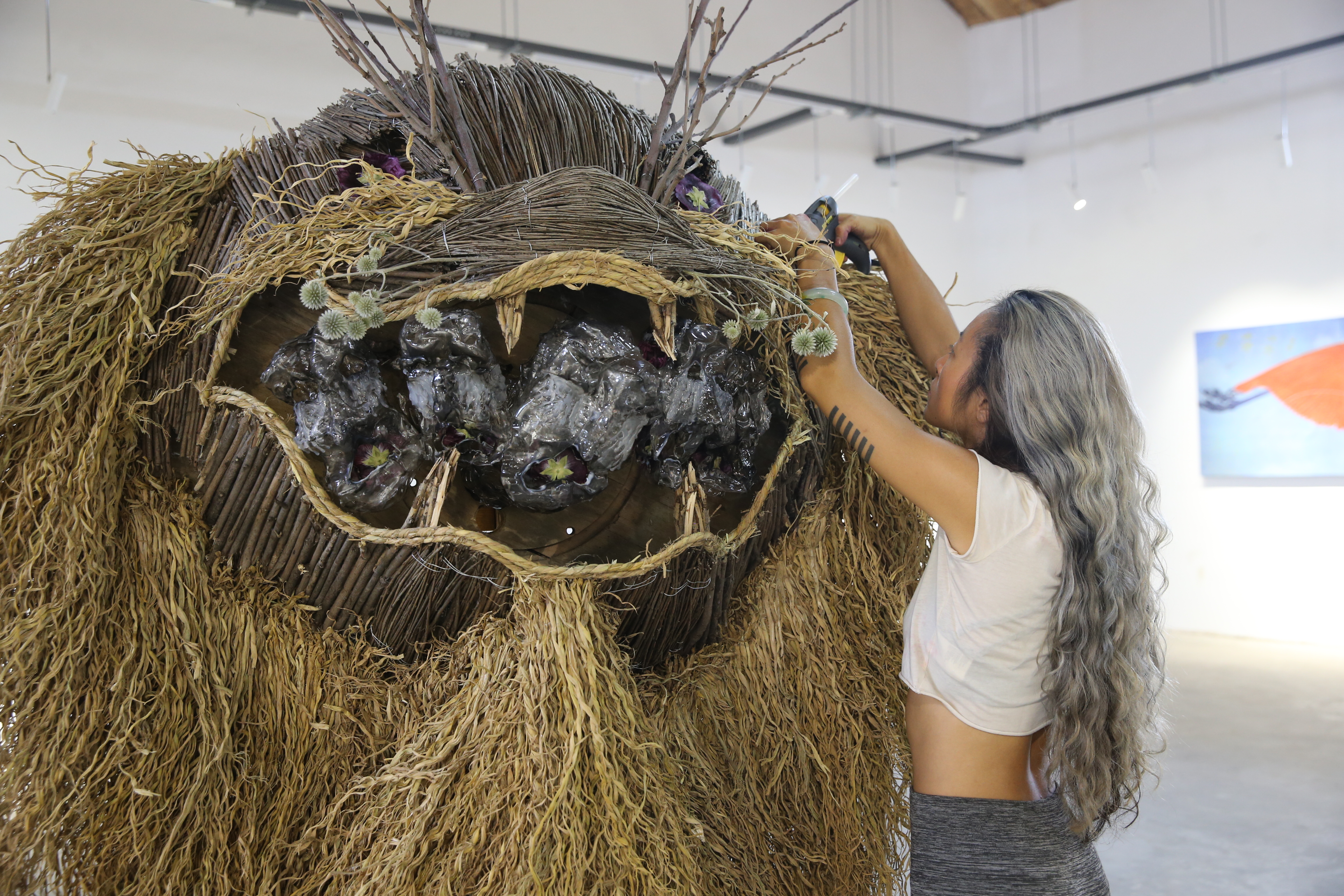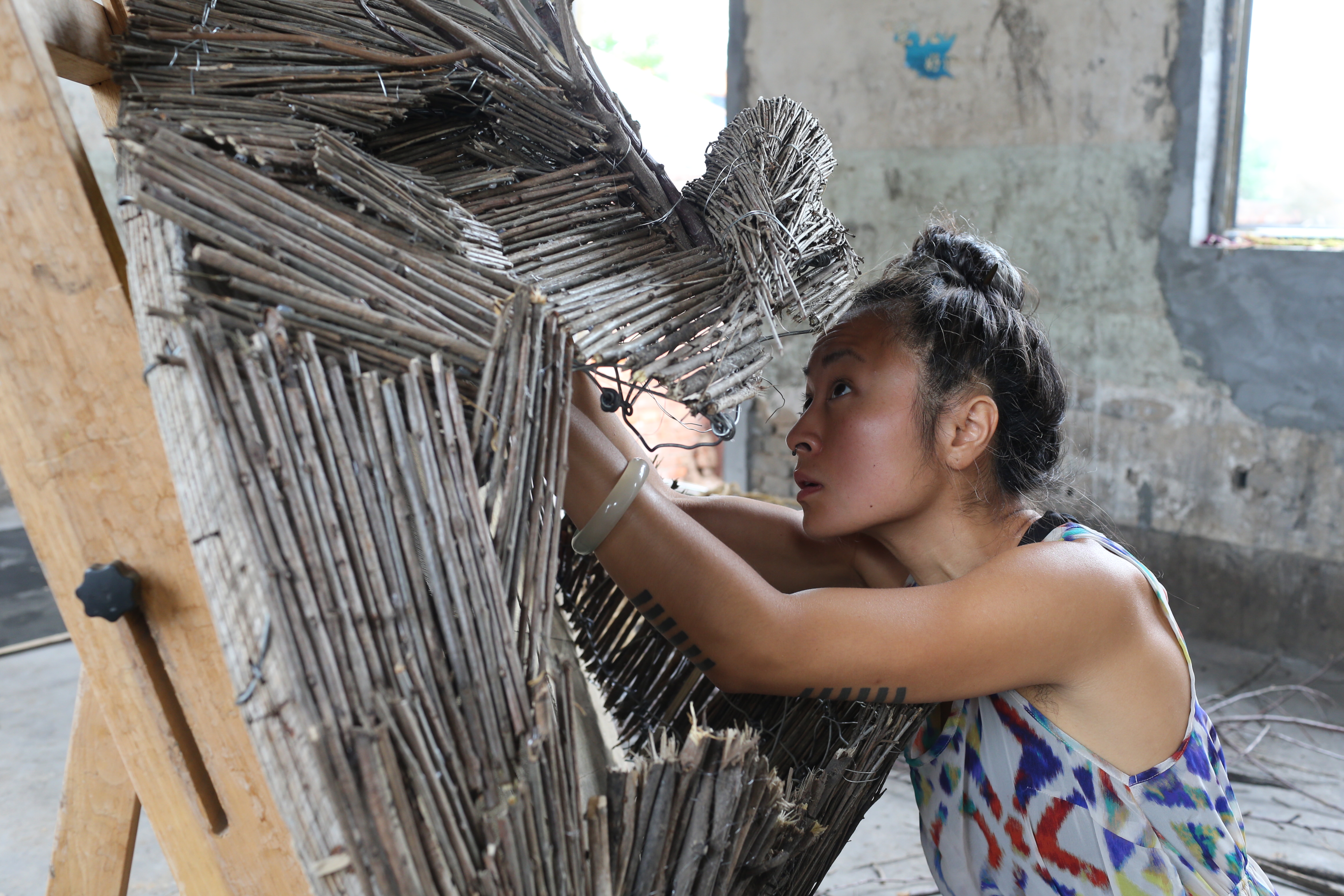Miss TANGQ is a Chinese-American multi-media artist and first-generation mystic-nerd. She is deeply inspired by the hyphenated experience and explores this through mask-making, animation, installation, and performance art to create cross-sensory and interdisciplinary work. Working between Asia and the West Coast ASIA ART TOURS had the chance to speak with this dynamic and bold artist:

- Can you tell us a bit about your background? Where did you grow up, and what path led you to become a full-time artist?
I was born in Chongqing, China and came to the US when I was four years old. Like many first-generation families where the emphasis was on assimilation and traditional markers of success, there were no examples in my family or a paradigm in my childhood upbringing that supported a career path in the arts. Although my family members didn’t provide the emotional support, I would say my relationship to lineage and heritage supplied the karmic support for why I became an artist.
From a very young age, I could not have escaped being confronted with questions of identity. Exploring it through a solely deconstructionist and political lens was never satisfying enough for me. After years of doing educational and social justice work, I felt the pressing need to practice modalities of healing and creativity. I felt a new mission to open portals of imagination exploring the question of who we are and the future that we can create. I’m a self-taught artist – I studied intellectual history and philosophy, not art. Even though I came to do this work in non-traditional ways, both my personal and academic experiences provided the subject matter and conceptual backbone to what I needed to express. Once I committed to being an artist and persisted at it over time, my family started to see the value of what I was doing, especially my investigations into ancient Chinese culture and wisdom traditions.

- I have a hyphen because my mother was a Lebanese feminist who didn’t want to change her name when she married. What hyphens would be found in your work, as well as your sense of self (if any)? What does the “Hyphenated experience” mean to you?
I strongly believe that diaspora, queerness and the experience of otherness is actually a superpower. When you are forced to navigate multiple cultural, social and psycho-spiritual realities at one time, you develop very unique capacities of perception. Over the long process of maturing into myself as an artist and creator, I realized that being first-generation, gender-queer, straddling east and west, ancient traditions and modern urban life – all of the forces that have fractured and torn me apart, were exactly what made me an interdimensional being. I think this is the healing that is needed right now, especially in the current divisive political climate of the west. It’s so important not only to acknowledge the deep pain and challenges of the hyphenated experience but also to elucidate and practice its magical and alchemical potential. This exploration is at the core of what compelled me to become an artist – my process of transforming the hyphen from a rift to a bridge, and the theme of crossing over. These days I am interested in the subjects of crossing over between the visible and invisible worlds, the conscious and subconscious realms and hybridizing ancient and future technology.
- Your Mask making work is very interesting to me in this increasingly technical age. Why did you decide to create masks as an artist? And what links do you see between traditional mask-making and the digital ‘masks we make for ourself now (our Facebook profiles, our twitter accounts)?
It’s interesting to look back at my creative “choices” and try to make meaning of them. I can’t determine any one moment when I decided to start making masks – it’s like they just started coming out of my hands. In retrospect, I guess I can say that it was a natural extension of my obsession with identity as both a personal and creative exploration. But there is also a mysterious process in creating them where I had to interact with the entity of each mask, which spoke to me with a distinct voice about its origins, preferences and needs. I’d say that my predominant experience with mask making was dialoguing with the palpable spirit within each one of them that desired to come through. I also used the Yijing as my co-creator, asking the oracle how to make choices in the creative process. Mask making began as a way for me to commune with the invisible, mysterious forces and materialize them into form.
I am fascinated with the richness of metaphors, functionality, and varied applications that masks have had in human history across the globe, and how we can apply them to today. Identity is not a new concept but something very primal to our human experience, evidenced through how our ancestors used masks to obscure, transform and channel identity. I’ve created workshops for groups and done private commissions where I explore the complex process of identity-creation through mask making. In this digital age, corporations are now the accepted platforms for the rituals of self-making. Our rites of passage, how we are witnessed by the greater community and the stewardship of the development of our youth are now channeled through social media and the making of virtual identities through the web. The power to create yourself is becoming more universal and accessible, yet the intentionality and direction for how to do so is increasingly lost. Just imagine if every selfie was captured with the purpose of awakening a new potential self, which was supported by the larger community witnessing this creation. We need alternative rituals that are infused with deep intention, reflection and purpose for the selves we are trying to evoke.

- I’m wondering if you could talk specifically about the Oracle installation? How did this come about and why did you decide to fuse so many elements of the mystical with the technical? Why does it seem now that we as a world society put more faith in a computer algorithm to predict our future than we would a traditional fortune teller?
The Oracle installation was the first collaborative project between myself and my partner, Louis Chin, who is also a multi-media artist as well as a musician. We worked together to design and construct the immersive temple sculpture, which participants enter inside to receive a custom Yijing reading. He wrote and produced the music and I created the animations that play at the bottom of a well inside the temple. We also worked with a creative technologist that used the sacred math of the Yijing to write the code allowing for participants to trigger the installation by touch.
At the core of this project were some philosophical questions that Louis and I explored regarding the intersections of nature, art, technology and human nature. Is nature and technology fundamentally opposed or only by human definition? If we as humans are a part of nature, is the technology we create also a part of nature? For instance, electricity is composed of water, metal and magnetics. Can these elements of high conductivity also be used to channel divine messaging? What is technology’s role in the development of human consciousness? Is it possible to use the technology of today in service of bringing ancient technology to life (such as the Yijing, the oldest recorded form of divination)?
We received a lot of interesting feedback from participants that commented on The Oracle’s capacity to act as a medium for the user. Does this mean we can put more faith in a computer or that it can replace a traditional human diviner? I think every medium has its power and limitations and its usage should be adapted to its capacity. I have a practice of giving readings myself using the Yijing and Bazi (Chinese astrology), and at the very least I believe it is worthwhile for us to explore how technology can work in tandem rather than in competition to the human diviner, such as introducing these practices to a wider audience through an artistic experience.

- I was a queer resident of Cap Hill, and absolutely loved your “Agro Bro”art. For that artwork, and political art generally speaking, how do you know you’ve reached the point where dialogue is no longer possible and that resistance is the best path forward? Moreover,what are you dialoguing with at the moment and what are you resisting?
Currently, I am trying my best to resist the belief that there is a point where dialogue is no longer possible. When we give up on dialoguing – meaning our capacity to both speak and listen, then our ability to resist is also over. I truly believe that there is no effective resistance without this exchange. We need to start exploring the opportunities that lie hidden within our challenges rather than taking the easy road out, especially when faced with seemingly impossible situations where the odds are stacked against us. I draw inspiration from examples such as Daryl Davis, a black blues musician who spent 30 years befriending members of the KKK and converted over 200 klansmen to give up their robes through talking with him. And what was the medium through which he had his first conversation with a klansman? Through the third language of music. I think we underestimate our individual and collective creativity, resourcefulness and willpower to make meaningful, transformative exchange happen. It can only be a failure of the imagination to say that we’ve exhausted every faculty of the human experience to create dialogue.
I think this is also where humor, playfulness and the trickster archetype have immense power because it invites and provokes people into conversation. This is the strategy I used with the Agrobro posters, which was part of a public service campaign drawing attention to the increased homophobic violence in the rapidly gentrified neighborhood of Capitol Hill, the historically queer haven of Seattle. Knowing that the new resident techbros were here to stay, I took the approach of educating them with tongue-in-cheek welcome signs with “do’s” and “don’ts” to address their ignorance of the pre-existing culture they landed in. Rather than taking a combative approach and thereby fueling their aggressiveness, I wanted Agrobro to recognize himself in these caricatures and be solicited (with equal parts humor and humiliation) into proper conduct with the community.

6.Carl Sagan famously called science a “Candle in a demon haunted world”. By that he meant science showed us the ‘true’ way of the world and shined a light on the ignorance of folk-beliefs, mysticism, and religion. Your art seems to point to a more optimistic future, one where there is possibly a path forward for restoring balance between technology and art? Why do you believe in this future and what can we do to reach this balance? How can art cooperate with tech and how can tech cooperate with art?
Carl Sagan is as much a hero to me as mythologist Joseph Campbell, and in my universe they work together. The ancient technology of esoteric traditions and mythology provided systems of wisdom that our ancestors used as a compass in their journey through life. When we extracted knowledge from storytelling, we removed it from its wisdom core of guiding principles. This is how we ended up in the Information Age, with access to instant infinite knowledge, but a lack of direction for how to navigate the increasingly complex circumstances of modern life, in which the influence of individual choice is more of a burden than ever. I’m not a primitivist by any means in the sense that I would want to get rid of modern technology. I am much more interested in exploring how to re-combine knowledge and technological progress in service to the wisdom roots of ancient traditions.
I think this is another application of the hyphenated perspective that is needed in the fields of science, philosophy and religion. Outdated beliefs and superstition are rife in traditional practices, alongside what I believe are deeply rewarding and functional applications. We need to upgrade ancient technology because its guidance is so needed today. We need to apply science and current technology for the pursuit of compassion, understanding and wisdom. I think that in the alchemy of artistic practice and experience, we are primed to explore these intersections.
 To meet, interact and create with more amazing artists like Miss TangQ contact Asia Art Tours! We are creative travel for creative people.
To meet, interact and create with more amazing artists like Miss TangQ contact Asia Art Tours! We are creative travel for creative people.

